Way, way back, dating some 65,000 years ago in Aboriginal culture, Dreamtime Stories tell us of how the universe and the world came to be, in a mystical period of the Aboriginal beginning. It was a time when rivers, mountains, rocks, deserts, plants, animals, human beings and nature were made.
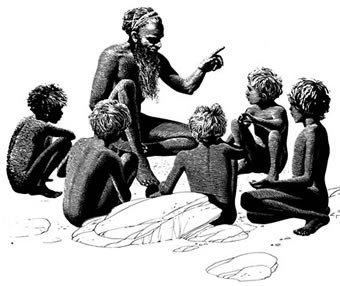
Dreamtime is the foundation of Aboriginal religion and culture. It is the Aboriginal understanding of the world around us; explaining the creation process in myths and legends, told in stories by Australia’s first people. The Dreamtime is the beginning of knowledge and represents the time when Ancestral Spirits advanced over the land and created life, important physical geographic formations and sites. The Aboriginal spiritual beliefs are ‘earth-centred’ and intimately associated with the land Aboriginal people live on.
Dreamtime stories are passed down the next generations in the oral traditions, as there was no known written language. The Dreamtime is part of the oral tradition and is only one aspect of a very complex spiritual belief system called the Dreaming.
1. The Rainbow Serpent
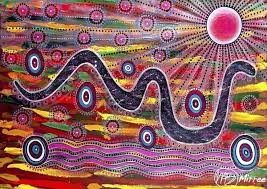
Undoubtedly the most well-known legend in Australia, the Rainbow Serpent is a perfect example of a Dreamtime story. Whilst there are many regional variations, shaped by indigenous cultures and language communities; the common theme is that an enormous snake dozes beneath the Earth’s surface until it makes an appearance from the ground to awaken different groups of animals. It then travels through the previously flat, dry and empty land, creating lakes, valleys and rivers. This Supreme Being is known as Wuagyl or Goorialla but has many other spelling variations. It is known as the giver of life but reveals terrible rage when crossed.
The Dreamtime Story suggests that the Rainbow Serpent one day woke from his sleep and travelled the land to look for his tribe. As he did so, his large, long body cut huge gorges into the land. He did not find anyone so rested all alone until he decided to create more life to keep him company in the world. He commanded the Frogs to come out of the land and then he tickled their watery bellies until the water burst from their mouths. The water filled the gouges, making the rivers and streams we see today. As the water flowed over the land, grass and trees began to grow and fill the land with colour.
As there was no grass to eat or water to drink; the Rainbow Serpent woke the other animals. The animals rose up from the land, sea and sky to gather food and bring it back to their own tribes. The Rainbow Serpent set down some rules and any animal who disobeyed the rule was made into stone that made a mountain. As a reward for obeying the rules he made them into humans.
One day it started to rain, and two young men asked the Serpent to shelter them. The Serpent was hungry and tricked the men saying they could hide in his mouth, then proceeded to eat them. He then realised people would notice they were missing and follow their tracks leading to his mouth. So, as a solution, he decided to hide in the sky, but whilst doing so, he was able to see how unhappy the people were at losing the two men. He decided to cheer them up by turning his body into a beautiful arc of colours! Every time after it rains, he shares the rainbow colours with the people as his way of saying sorry.
2. The Didgeridoo

The Didgeridoo is one of the world’s oldest instruments and is an essential part of Aboriginal storytelling.
The most common Dreamtime story is that Yidaki, a warrior coming home from the hunt, saw a hollow log lying on the ground. It was larger at one end and had termites crawling out of it. When he picked it up, he saw daylight coming through the other end. He then tried to blow the termites out and heard a sound like the beginning of time – at the creation of the universe. He found that when he continued blowing, he could use his breath in a way that made the sounds seem endless. He also found that inside the instrument, there were the sounds of animals and voices that he could play endlessly.
Yudaki is not the only dreamtime story about the didgeridoo. Some tribes say that the didgeridoo was invented by the Gods and used as a tool in the creation of the world. Legend has it that the didgeridoo was a long horn or hollow reed in which holds the voice of the kindly carpet snake god “Cunmurra” and brought to earth by the Song maker “Kudajuk”. The songs he played were given to him by the great Earth Mother, then the red bellied black snake helped sing the songs and chants into the wooden horn, so music came to earth to make people happy.
Traditionally Aboriginals would go into nature and listen intently to animal sounds, their voices, flapping of wings or noises as they walked on the ground. The Aboriginals would also listen to trees creaking, running water, wind and thunder. The fundamentals of all these sounds were played with as much accuracy as possible with the low humming sound of the didgeridoo. The didgeridoo has been used for thousands and thousands of years to sing songs, send messages across the great expanses of the Australian outback and bring tribes together.

3. The Emu in the Sky

The Emu in the sky has featured in Aboriginal storytelling for thousands of years. The Aboriginal people developed an astronomy where figures from their mythology were represented by the stars, dark patches and other features in the night sky. The patterns of the sky came from familiar objects and animals in their surroundings and related the natural world to the heavens above.
When you look closely at the Southern Cross in the night sky from south, toward south east, in March, the head and neck of the Emu appear! Then from April to May the full length is of its body is revealed. During this time the Emu is said to have legs and is seeming to be in running pose. In dreamtime stories, this represents females who are chasing the males during mating season. This is also the time when emus begin to lay their eggs. In the Aboriginal calendar this is a reminder of the time of year when the emu egg is available for them to collect. During June and July, the Emu’s legs seem to disappear and the Emu changes positions. This is said to represent a male sitting on its nest. As in nature it is the male emu which incubates the eggs.
As you look at the constellations of the Milky Way, the Emu’s head is represented by the Coalsack nebula; an opaque cloud of dust and gas next to the Southern Cross. The body and legs are other dark clouds trailing out along the Milky Way. However, some Aboriginal groups see the head as a lawman or a possum in a tree.
In the Dreamtime story of the Emu in the Sky, it is told that there is a blind man living in the bush. Tormented by uncontrollable hunger for emu eggs, he would tell his wife to go and find him some each day. She would always return with the eggs, but he would then say the eggs were too small. One day on her search, the wife found a giant emu tracks which she followed in the hopes of finding a large egg to please her husband. Sadly, she was killed by the emu when she tried to get at the eggs. The blind man became concerned for his wife, as she had not returned. In his hunger started feeling around for fruit in the bush. He found a bush with berries on them and as he ate the fruit. Suddenly, he was able to see, so immediately went looking for his wife. As he followed her tracks, he found her dead body and killed the emu banishing its spirit to the Milky Way, where it can still be seen today.
Once you have seen the Emu in the sky, the Milky Way will never look the same again!
4. Uluru

http://www.uluru-australia.com/about-uluru/aboriginal-uluru-dreamtime/
There are many Ancestral sites in Australia, but few are as important as Uluru! The rock carries special spiritual significance for the local Aboriginal people and many cultural ceremonies have taken place at the rock for over 10,000 years.
Also known as Ayes Rock, Uluru is believed to have been created at the beginning of time by 10 ancestors who were spirits of the Aboriginal people. These spirits had a connection with the local Anangu Aboriginal people. It is believed that the world was a featureless place until these ancestral spirits of Anangu travelled across the land creating features like Uluru that we see today. These creation beings gave the Anangu people important lessons on how to behave. The rock’s caves, cliff faces, and crevices contain many rock carvings that tell the story of their ancestors. Some of the rock face sticks out and is said to represent ancestral spirits. The Anangu people believe that by touching the rocks they can communicate with dreamtime and receive blessing from their ancestors.
Each side of the Uluru had a different creation story associated with it. The more well-known dreamtime story comes from the south side and is of a Tjukurpa of Kuniya; the sand python who was seen coming down the rock to lay her eggs. After she had laid her eggs, she became angry and did a ritual dance and covered herself with the earth. She was angry because her nephew, a young womb python snake boy, called Kuniya, had been ambushed by venomous snakes called the Liru. In the spear attack, Kuniya was killed and the spear left a mark on the rock. When the sand python Aunt heard about her nephew, she was angry with the Liru and after a furious chase, took revenge by hitting one of them across the head, resulting in his blood spilling on the rock. He fell dead, dropping his shield. The blows she struck are now two deep cracks on the western wall and the Liru’s shield is now a large boulder and lies where it fell. All this can be seen by marks in the Uluru rock face.

https://parksaustralia.gov.au/uluru/discover/culture/stories/kuniya-liru-story/
5.The Three Sisters

In the Blue Mountains at Echo Point in Katoomba, there are three majestic rocks carved from the cliffs capturing the afternoon sunlight. These three ‘sisters’ spark the imagination of a dreamtime tale.
It is told that long ago in the Blue Mountains there lived three Aboriginal sisters, called Meenhi, Wimlah and Gunnedoo. They lived in the heart of the Jamison Valley as part of the Katoomba tribe. Three brothers from a neighbouring Napean tribe, captured their hearts and they fell in love. Yet the tribal law forbade the girls to follow their own desires and marry outside their own people. The brothers decided to use force to capture the girls and take them away to marry them, which sparked a terrible battle between the two tribes. A witch doctor from their Katoomba tribe was scared for their safety and cast a spell to turn them into stone, in order to protect them. He had intended to reverse the spell when the battle was over. But during the battle the witch doctor was killed, and their spell could not be reversed. So, the sisters remain in the enchanting rock formation as a reminder of the battle for future generations.

6. Tiddalick the Frog
In Dreamtime, the story goes that in the beginning of time there lived a frog called Tiddalick who was the biggest frog in the world. One warm morning, he woke up and was very thirsty. He began to drink up all the water from the billabongs, rivers and lakes until there was no water left for all the other animals and people to drink. They knew that it was Tiddalick who drank up all the water, so they held a meeting to come up with a plan. The wise owl said that if Tiddalick was made to laugh, the water would come spilling out of his mouth. So, all the animals approached Tiddalick and tried to make him laugh. The Echidna rolled in a ball then rolled down the bank, the wombat danced on his hind legs and fell over and the Kookaburra told her funniest story but Tiddalick didn’t laugh; he just sat there with his swollen belly of water. Finally the eel began to dance wriggle and eventually tied herself into a knot as she struggled to untie herself, Tiddalick began to chuckle and his big fat belly started to wobble. He had to hold his sides to stop laughing but he laughed and laughed until all the water came gushing from his mouth, which resulted in a flood, filling all the waterholes and lakes. The animals and people were no longer thirsty, and the land was restored to a paradise.
The water holding frog is found all over Australia. It earned its name because it can store water in its body to drink as well as holding water in its skin pockets for absorption when there is a drought. The frog spends a lot of its time underground and emerges after it has rained in order to breed

7. Why the Crocodile Rolls
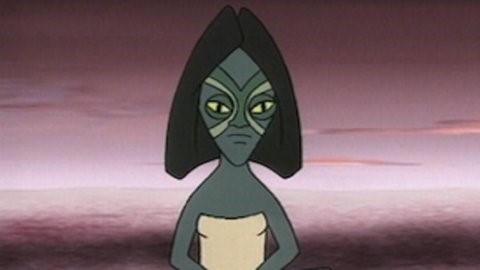
The short story of ‘why the crocodile rolls’ is told on the north coast of Western Australia by the Indigenous people. It is about an unhappy little girl called Min-na-wee, who, ever since her birth she had been a trouble maker. She was mean spirited and caused fights amongst her tribe. She would tell lies and spread stories to cause trouble. Her mother was warned that if she did not stop her daughter from causing trouble, then something bad would happen to her. As the years passed and she grew up to be a young woman, she was not chosen to become a wife which made her cause even more trouble. The Elders of her tribe agreed that Min-na-wee must be punished for her behaviour. They grabbed her and rolled her around in the dirt, however, she managed to escape and ran to the edge of the sea. Intent on revenge, she asked the evil spirits to change her into a vicious animal and was immediately changed into a crocodile. Then she waited in the water in anticipation for one of the Elders to jump into the water. The moment one did, she grabbed him and rolled him around and around in the water, just as he had done to her.
Since then Min-na-wee’s spirit remains in every crocodile and that is why every time that a crocodile catches its prey it always will roll around and around in the water.
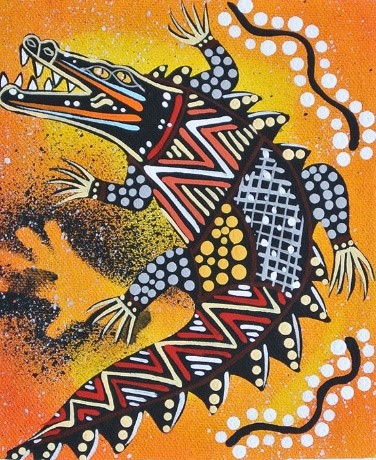
8. How the Kangaroo got its pouch
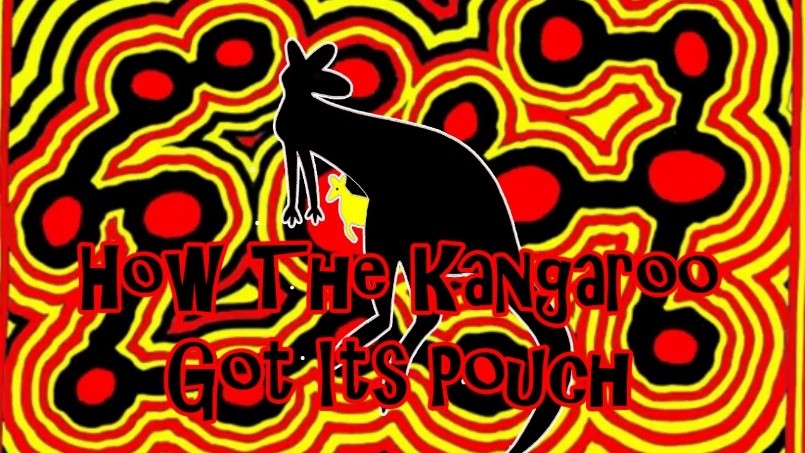
The dreamtime story tells of a mother kangaroo, who was finding her young joey a real handful and whenever her back was turned, he would go hopping away to explore. She was afraid that one day she may lose him. One day as they were both feeding on the grass, a weak old wombat came towards them. He was sick and blind, as well as being hungry and thirsty with no friends in the world.
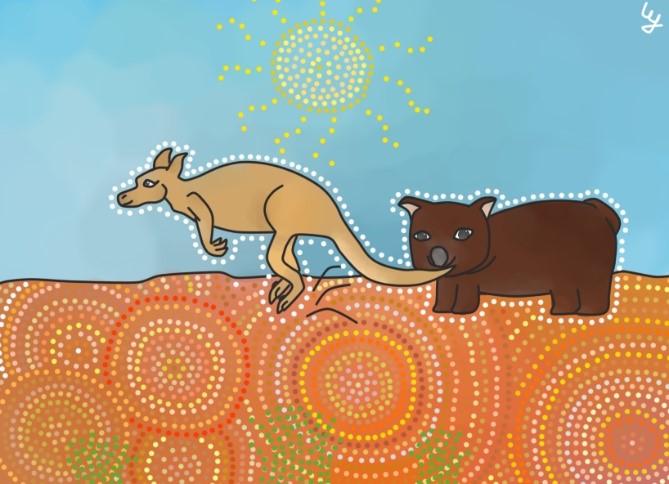
The mother kangaroo felt sorry for him and told him that if he hung on to her tail, she could take him to where there was water. The journey was difficult, as the wombat kept letting go of the kangaroo’s tail and joey kept getting left behind. They eventually got to the water hole, where the wombat was able to quench his thirst. He then complained he was hungry, so mother kangaroo told him to hang onto her tail again and took him to where there was lush grass. The journey was again difficult for the wombat and the joey. The joey became tired and wanted his mother to carry him, but she couldn’t because she had short arms. After finding a good spot for the wombat to eat grass the mother kangaroo sensed danger. A hunter appeared carrying a boomerang and went for the wombat, so she jumped up and down to attract his attention. The hunter realised that the kangaroo would be better to eat than wombat, so he chased after her but could not catch her and eventually went home disappointed. As she returned the wombat and her joey were not there. She searched everywhere, until she finally found him asleep under a gum tree and all he knew was that the wombat had disappeared.
They did not know that the wombat was the spirit of the creator who came down to earth to find and reward the kindest and gentlest of all animals and the kangaroo had earned that reward. So, while she slept, he left her a shopping bag made of string next to her. When she woke, she was not sure what to do with it, so she tied it around her waist and in an instant the spirit turned it into a pouch. So now the joey had a safe place where she could look after him. Since then Kangaroos and furry marsupials have been the only animals that have pouches to look after their children.
9. How the birds got their colour
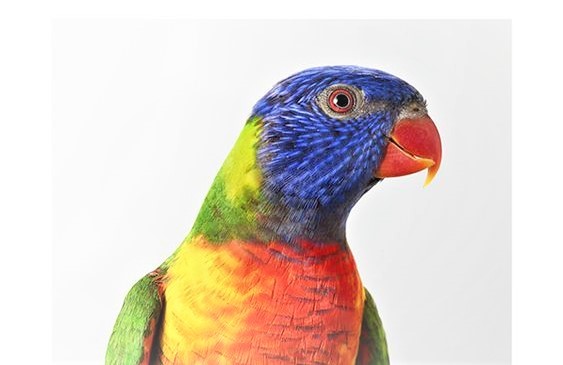
Long ago in the dreamtime, when the land and animals were being made; all the birds were black until one day, a little dove flew down to the ground to catch a big juicy bug. Instead of being rewarded with a meal, he landed on a sharp stick which pierced his foot. The Dove was in great pain and his foot had swollen up. All the other birds, except the crow, gathered and provided shelter for him with their wings. The crow just wandered around with its hands behind its back. Suddenly, the parrot jumped forward and burst the swelling on the dove’s foot with its sharp beak. Colour spurted out all over the parrot, running all over her feathers. It splashed other birds too, some got orange, some got red, some got brown, some blue and some yellow. Some got spots, some got stripes all with colours, all except the crow who was not standing near them. He got no colour at all. The dove soon got better and thanked the parrot and was well enough to fly away.
Crows have remained black till this very day!
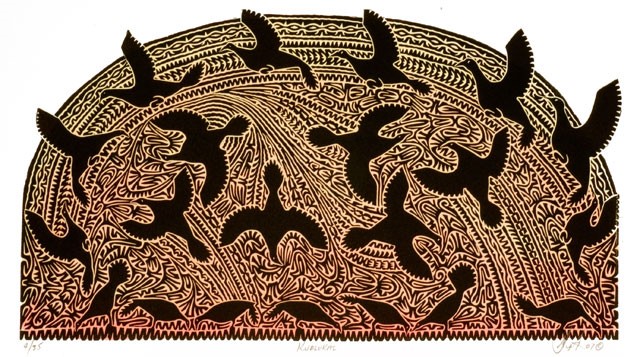
10. Why Emus can’t fly
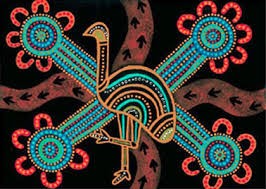
Wongutha dreamtime stories tell us that in the beginning of time, emus could fly. There were many of them and they were the biggest birds in the air. They flew together in large numbers and looked like dark clouds moving slowly through the sky. They could see many things that were happening on the ground and felt pleased with themselves.
Small birds shared the sky and animals were happy moving around the bush. The emus thought themselves as better than the other birds because they were big and powerful and became quite stuck up. They began to boast about being the best and became evil minded and mean, scaring other birds by looking vicious and flapping their wings. Soon the small birds lost their will to sing and the bush became silent.
They decided to stop the emus bullying by asking the wedge tailed eagles to chase the emus out of the sky. They agreed and the hawks joined them but even this powerful team could not defeat the big, strong emus. So, the birds asked the animals to help them, but they would not, as they feared what the emus might do to them.
Upset and angry the birds flew off and went to the headman of the Wongutha tribe, who said he would sing a special song for the emus and they must wait in the trees and watch. He started singing in a high-pitched voice and the emus flew in to listen and as he finished, he turned and disappeared in to the bush. As morning broke the emus stretched and flapped their wings to fly but nothing happened as their wings had become stumpy and too small. The emus were bewildered until they remembered the words of the song, they had heard the elder sing. The words said that they were boastful and will not fly again only walk and run. The small birds who were watching in the trees were delighted and started to sing again. The Wongutha elder felt sorry for the emus, but said the good thing was that the emus can now wonder through the bush as the country was big enough for all of them. After this the emus had learned not to boast but to mind their own business.
